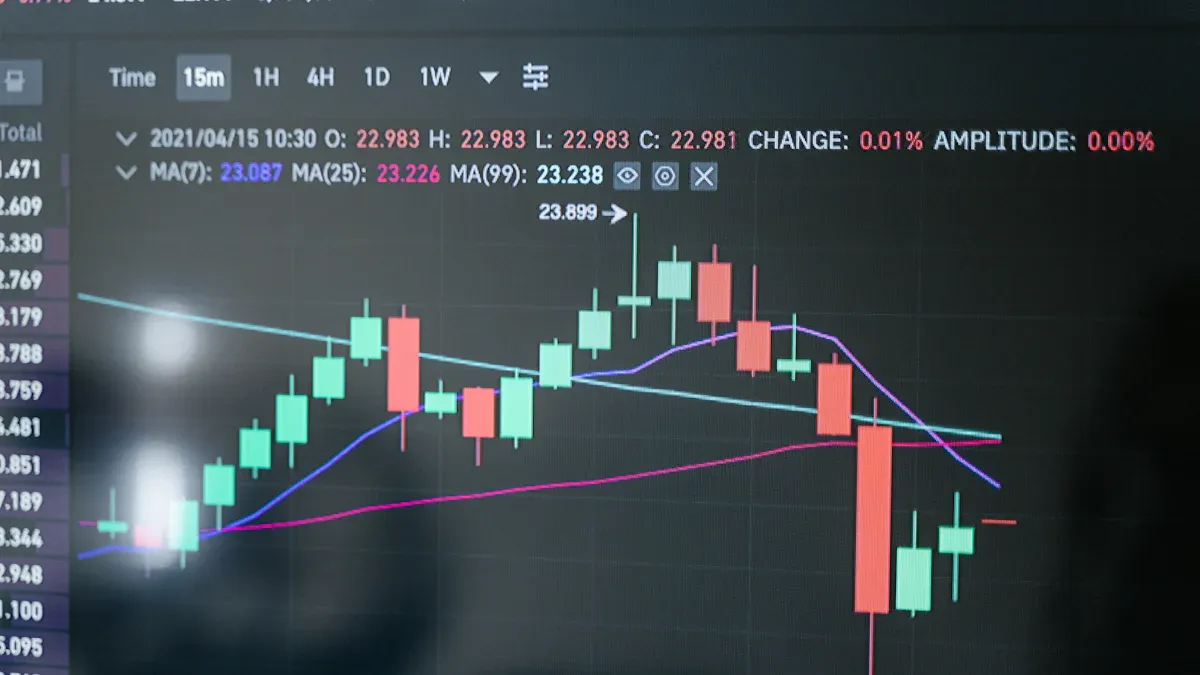- EasyCard
- Trade
- Help
- Announcement
- Academy
- SWIFT Code
- Iban Number
- Referral
- Customer Service
- Blog
- Creator
Key Metrics Analysis in Red Chip Index Data

Image Source: unsplash
Key metrics in red chip index data directly influence market performance. By analyzing red chip-related metrics, you can gain deeper insights into market volatility, investment returns, and potential risks. Data analysis not only improves investment efficiency but also helps you uncover business opportunities. For example, after Walmart adopted an AI data analysis system, inventory management efficiency increased by 30%, stockout rates dropped by 15%, saving billions of dollars annually. A global bank used a similar system to detect credit card fraud, improving accuracy by 60% and reducing losses by tens of millions of dollars annually. These cases demonstrate that data analysis applications enable businesses and investors to maintain competitiveness in the red chip market.
Basic Concepts of the Red Chip Index
Definition of Red Chips
Red chips refer to stocks of Chinese companies listed in Hong Kong. These companies are typically controlled by the Chinese government or state-owned enterprises and use Hong Kong as their primary financing platform. You may notice that red chip stock price increases are not entirely dependent on fundamental factors. Research shows that stock popularity, news coverage, and analyst confidence have a greater impact on stock prices. Fund managers are optimistic about the future of red chips, which also drives market activity. These characteristics make red chips a focal point for investors.
Composition of the Red Chip Index
The red chip index consists of a series of red chip stocks listed on the Hong Kong Stock Exchange. These stocks span multiple industries, including finance, energy, and technology. The index is designed to reflect the overall performance of Chinese companies in the Hong Kong market. You can track the index to understand overall market trends. The index’s constituent stocks are periodically adjusted to ensure their representativeness and market relevance. This makes the red chip index an important tool for investors to analyze the market.
Market Role of the Red Chip Index
The red chip index plays multiple roles in the market. First, it serves as a reference indicator for investors to evaluate the performance of Chinese companies. Second, it provides a benchmark for fund managers to allocate assets. Finally, it attracts international capital to the Hong Kong market, enhancing market liquidity. You can use the red chip index to formulate investment strategies and adjust your portfolio based on the index’s volatility. This not only helps reduce risks but also enhances investment returns.
Key Metrics in Red Chip Index Data

Image Source: pexels
Role of Dividend Yield
Dividend yield is an important metric that measures the relationship between a company’s dividend payments and its stock price. It helps you assess the stability and return potential of an investment. The role of dividend yield varies under different economic conditions. For example, during periods of high market volatility, stocks with high dividend yields are typically more attractive because they provide stable cash flows. Below are some statistics on dividend yield:
| Observation Item | Data Description |
|---|---|
| Contribution of Dividends to Total Returns | Over the past 40 years, dividends have accounted for over one-third of total returns in European stock investments. |
| Dividend Stability | Companies often increase dividends rather than reduce them, even when profit growth slows. |
| Stock Price Volatility | Companies that pay dividends typically have lower stock price volatility compared to those that do not. |
You can see from these data that dividend yield not only affects investment returns but also reduces investment risks. For red chips, stable dividend payments often attract long-term investors, further enhancing market stability.
Value of Price-to-Earnings Ratio
The price-to-earnings ratio (P/E ratio) is another key metric used to measure the ratio of a stock’s price to its earnings per share (EPS). It helps you determine whether a stock’s valuation is reasonable. A low P/E ratio may indicate that a stock is undervalued, while a high P/E ratio may reflect high market expectations for the company’s future growth.
In the red chip market, the value of the P/E ratio is particularly important. Since red chips cover multiple industries, their P/E ratios may vary due to industry characteristics. For example, technology red chips typically have higher P/E ratios because the market expects greater future growth potential. You can compare the P/E ratios of different red chips to identify attractive investment opportunities.
Significance of Volatility
Volatility reflects the magnitude of market price fluctuations and is an important metric for measuring market risk. For red chips, volatility helps you understand market stability and potential risks. Below is the specific manifestation of volatility in red chip data:
- Volatility reflects market risk and liquidity risk.
- Economic factors in emerging markets may lead to sharp price fluctuations.
- Funds investing in red chips may face higher volatility and risks.
When volatility is high, the market may be in an unstable state, requiring investors to be more cautious. You can use volatility data to adjust your portfolio and reduce risks. At the same time, volatility also provides more arbitrage opportunities for short-term traders.
Impact of Trading Volume
Trading volume is an important metric for measuring market activity. It reflects the number of transactions for a specific stock or index over a certain period. For red chips, changes in trading volume can reveal market sentiment and capital flows, helping you more accurately judge market trends.
When trading volume increases, it usually indicates heightened market attention to the stock. This may be due to significant news, policy changes, or corporate earnings announcements. You can observe changes in trading volume to confirm price trends. For example, when a stock price rises with increasing trading volume, it may indicate stronger market demand for the stock, making the upward trend more sustainable.
On the other hand, a decrease in trading volume may signal declining market activity. In such cases, price fluctuations may weaken, and the market may enter a wait-and-see mode. You can use this information to adjust your investment strategy, avoiding large transactions during low-liquidity periods.
Historical data shows that trading volume analysis is crucial for formulating trading strategies. Traders can backtest historical data using tools like TradingView to evaluate strategy performance under different market conditions. Although initial backtest results may not be perfect, by repeatedly adjusting parameters and optimizing strategies, you can improve strategy stability and executability.
Below are key points about the impact of trading volume on the market:
- Indicator of Market Sentiment: Increased trading volume typically reflects growing investor confidence in the market.
- Confirmation of Price Trends: High trading volume accompanying price movements helps you confirm the validity of trends.
- Measure of Liquidity Risk: Low trading volume may increase liquidity risks, affecting trading efficiency.
You can combine trading volume with other metrics, such as price trends and volatility, to further improve analysis accuracy. In the red chip market, changes in trading volume not only affect individual stock performance but also reflect overall market capital flows and investor sentiment.
Historical Performance of the Red Chip Index
Review of Index Trends
The historical trends of the red chip index reveal multiple turning points in the market. You can use the following tools to understand the index’s changing trends:
- Parabolic SAR: A technical indicator used to analyze trend reversals, helping you identify market turning points.
- Pivot Points: Calculated based on the previous day’s price movements, these points help you identify key market turning points.
- Point and Figure Charts: These charts are created based on price movements, clearly showing price directionality, suitable for tracking long-term trends.
- Volume-Based Indicators: These indicators help you analyze changes in market trading volume, further confirming trend stability.
These tools not only help you review the historical trends of the index but also provide references for future market predictions.
Major Influencing Factors
The performance of the red chip index is influenced by multiple factors. You can analyze the role of these factors through the following metrics:
| Metric | Description |
|---|---|
| Creativity | Creative capabilities of internal personnel and the environment |
| Innovation | Innovative capabilities of internal personnel and the environment |
| External Innovation | Whether the company actively engages in external innovation |
| Data Analysis Tools | SPSS and AMOS for reliability and validity testing |
These metrics help you understand a company’s internal operations and external competitiveness, enabling more accurate assessments of the reasons behind red chip index fluctuations. For example, when a company’s innovation capabilities improve, market expectations for its future growth increase, driving the index upward.
Comparison with Other Indices
Compared to other indices, the red chip index has a unique market positioning. You can compare it from the following aspects:
- Industry Coverage: The red chip index covers multiple industries, including finance, energy, and technology, while other indices may focus on specific sectors.
- International Capital Participation: The red chip index attracts significant international capital, enhancing its liquidity and market influence.
- Volatility: Due to its close connection with the Chinese economy, the red chip index may exhibit higher volatility than other regional indices.
These comparisons help you gain a more comprehensive understanding of the red chip index’s market role and select appropriate indices for allocation based on your investment needs.
Market Trends and Investment Recommendations for Red Chips

Image Source: pexels
Current Market Trends
The red chip market has recently shown diversified development trends. You can use tools like Google Trends to quickly grasp real-time market dynamics. These tools provide multidimensional data analysis, such as “region” search results and “rising” keywords, helping you understand market hotspots and capital flows. Many research institutions and commercial analysts rely on these data for market studies due to their representativeness and ease of use.
Currently, red chip performance is influenced by multiple factors, including adjustments in Chinese economic policies and inflows of international capital. You may notice that red chips in the technology and new energy sectors are attracting more investor attention, with both trading volume and price volatility increasing. These trends indicate that the market is optimistic about the future growth of innovative companies.
Investor Selection Recommendations
As an investor, you should formulate strategies based on quantitative data and analytical results. Quantitative investment strategies, such as multi-factor models and event-driven strategies, can help you select investment targets more precisely. These strategies, combining financial econometrics and computer technology, have proven effective in practice. For example, classic value investment strategies are suitable for finding undervalued red chips, while market timing strategies help you seize optimal entry and exit points.
You can also refer to historical data to analyze the performance of different industries and select stocks with stable growth potential. For investors with lower risk tolerance, choosing red chips with high dividend yields may be a more prudent option.
Short-Term and Long-Term Strategy Analysis
Short-term strategies are suitable for investors seeking quick returns. You can use regression analysis and maximum likelihood estimation (MLE) techniques from statistics to analyze short-term market fluctuations and develop efficient trading plans. These methods help you adjust strategies based on real-time data, improving trading success rates.
Long-term strategies focus on stability and sustained growth. Bayesian inference techniques can update models based on historical data, improving prediction accuracy. You can use these techniques to select red chips with long-term growth potential and make periodic adjustments based on market trends. Decision theory can also help you formulate optimal strategies based on predictive results, achieving long-term investment goals.
Whether choosing short-term or long-term strategies, you should adjust them based on your risk preferences and capital scale. Combining market trends and data analysis, you can more effectively achieve investment goals.
Key metrics in red chip index data, such as dividend yield, P/E ratio, volatility, and trading volume, provide tools for gaining deep market insights. These metrics not only reveal market stability and potential risks but also help you assess the likelihood of investment returns.
The key to investment success lies in data analysis. By analyzing metrics, you can develop more precise investment strategies, reducing risks and enhancing returns.
Start leveraging these data now, combine them with market trends, and inject more intelligence and confidence into your investment portfolio!
FAQ
Which Types of Investors Are Suitable for the Red Chip Index?
The red chip index is suitable for long-term investors seeking stable returns. It also attracts short-term traders due to volatility providing arbitrage opportunities. You can choose appropriate strategies based on your risk tolerance.
How to Use Dividend Yield to Analyze Red Chips?
Dividend yield helps you assess a stock’s stability and return potential. A high dividend yield typically indicates stable cash flows. You can select red chips with high dividend yields to reduce investment risks.
How Does the Red Chip Index Differ from Other Indices?
The red chip index covers multiple industries, attracts international capital, and has higher volatility. You can use it to analyze the performance of Chinese companies in the Hong Kong market and compare it with other indices to find optimal investment opportunities.
How Does Trading Volume Affect Red Chip Prices?
Trading volume reflects market activity. When trading volume increases, stock prices are typically more sustainable. You can observe changes in trading volume to confirm price trends and adjust investment strategies.
Is Red Chip Volatility Suitable for Novice Investors?
Red chips may have high volatility, making them more suitable for experienced investors. Novices can choose stocks with lower volatility or adopt prudent long-term strategies to reduce risks.
Key indicators of the red chip index, such as dividend yield, P/E ratio, volatility, and trading volume, provide powerful insights into market trends and risks, while a flexible, low-cost trading platform can further enhance your investment efficiency. BiyaPay offers a seamless financial solution, enabling trading in U.S. and Hong Kong stocks without offshore accounts, allowing you to participate in the market cost-effectively, whether capturing short-term red chip volatility through high-frequency trading or investing in stable dividend-paying stocks for steady returns.
It supports USD, HKD, and 30+ fiat and digital currencies with real-time exchange rate transparency, helping you navigate exchange rate risks and liquidity challenges in red chip cross-border investments while ensuring fund efficiency. With remittance fees as low as 0.5% across 190+ countries, it simplifies fund allocation without high fees eroding returns. A flexible 5.48% annualized yield savings product with no lock-in period allows idle funds to grow during market fluctuations or while awaiting trading opportunities, perfectly complementing your red chip investment strategy. Sign up for BiyaPay today to combine red chip index insights with BiyaPay’s low-cost, flexible tools for an efficient, stable wealth-building journey!
*This article is provided for general information purposes and does not constitute legal, tax or other professional advice from BiyaPay or its subsidiaries and its affiliates, and it is not intended as a substitute for obtaining advice from a financial advisor or any other professional.
We make no representations, warranties or warranties, express or implied, as to the accuracy, completeness or timeliness of the contents of this publication.




Contact Us
Company and Team
BiyaPay Products
Customer Services
is a broker-dealer registered with the U.S. Securities and Exchange Commission (SEC) (No.: 802-127417), member of the Financial Industry Regulatory Authority (FINRA) (CRD: 325027), member of the Securities Investor Protection Corporation (SIPC), and regulated by FINRA and SEC.
registered with the US Financial Crimes Enforcement Network (FinCEN), as a Money Services Business (MSB), registration number: 31000218637349, and regulated by FinCEN.
registered as Financial Service Provider (FSP number: FSP1007221) in New Zealand, and is a member of the Financial Dispute Resolution Scheme, a New Zealand independent dispute resolution service provider.




















